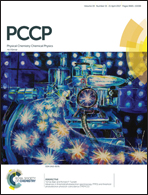Nucleation and growth of 2D covalent organic frameworks: polymerization and crystallization of COF monomers†
Abstract
We establish a theoretical foundation for understanding the nucleation and growth of 2D covalent organic frameworks (COFs) from solution. This foundation should make it easier to realize some of the unique properties of COFs in targeted applications by allowing us to understand how processing variables such as solvent choice and linkage chemistry lead to larger crystalline domains. We use free energy techniques to map out the reaction mechanisms and activation energies of three fundamental reactions that are responsible for the early stages of 2D COF nucleation for a prototypical and commonly used 2D boronate ester material, COF-5, in water and methanol solvents. We show that the presence of water and methanol greatly catalyzes the boronate ester formation reactions, lowering the activation energy barrier by about 10 kcal mol−1 relative to an uncatalyzed reaction pathway. This is in good agreement with experimental observations by Smith and Dichtel (JACS 2014). Our crystallization studies also conclusively eliminate certain proposed mechanisms of growth, such as polymerization of large sheets followed by stacking, while strengthening the case for templated polymerization as a likely growth mechanism for COF crystals.



 Please wait while we load your content...
Please wait while we load your content...